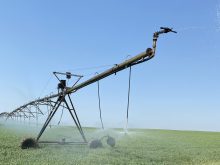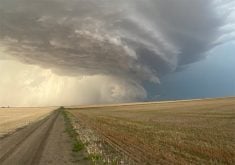Rising feed costs and the Canadian dollar are leading some cow-calf operators to consider backgrounding as a new revenue source.
“We’re hearing from cow-calf producers looking to get into the business,” said Susan Eckland, executive director of the Saskatchewan Cattle Feeders Association during the organization’s annual Feedlot Management School held in Saskatoon at the beginning of August.
Getting advice from those in the industry during the planning process avoids costly mistakes.
Stan Jeeves of Wolseley, Sask., has a cow-calf operation, with backgrounding and finishing businesses.
Read Also

Rented farmland jumps 3.4 million acres in Saskatchewan and Alberta
Farmland rented or leased in the two provinces went from 25.7 million acres in 2011 to 29.1 million in 2021, says Census of Agriculture data.
He said many producers enter the backgrounding business after a trip to the auction market where they pay a reasonable price for some lightweight calves.
“A couple of months later the auction market calls offering to sell those calves for you and get you some more. Flipping those 600 (pound) calves after you’ve been getting 1.5 lb. of gain on them (per day) just when they are about to start putting on three lb. is good for the auction mart, bad for you. Consider holding them longer into the easier-feeding January through March period,” he said.
“Remember, most deaths occur in the first 45 days on feed.”
Jeeves said producers need to consider their whole operation before they get into cattle feeding.
“Will it let you market your grain at a greater profit? Does feeding add value to your products? … We’re no longer in the grain business or the cattle business if it does. We’re in the meat business and you have to think that way,” he said.
Chad Ross of Ross L7 Ranch, Feeders and Tender Meats in Estevan, Sask., said being able to feed cattle lets his family obtain a southern Alberta price for their barley and animals without paying the commissions or trucking.
“Any time you take out a layer of middlemen, you put money in your own pocket. Sometimes you have to become a middleman to get it to the scale that it’s profitable, but with rising grain prices, there are going to be opportunities in feeding going forward,” he said.
Myron Tatarniuk of Grasslands Cattle Co. in Yorkton, Sask., has feeding and marketing data on more than a quarter of a million cattle that he has handled. He said cattle feeding requires sound risk management strategies whatever the state of the cattle or feed market.
“We’re going to see $6 wheat and $9 (soy)beans and a lot of volatility in the markets and the dollar…. Use the (financial) tools available to you to manage the things you can’t control,” Tatarniuk said.
Jeeves said smaller cattle feeders usually require a relationship with a company to help with contracting and hedging.
“Hedging (feed and sales) takes out the risks that you have less control over,” he said.
“You need to be disciplined in your hedging,” said Brian Perkins, a Saskatoon area cattle feeder. “You can’t one day look at a high price for your paper (hedge) and decide to cash in and expect not to see a big downside on the cash (sale) later on. Somebody else that does it for a living already factored that into the price you just got paid.
“You placed the hedge to protect your profit. Take your profit and live without the ulcer.”
Perkins said poorly arranged financing is another obstacle that will sink a fledgling feeding business.
Pat Killoran of the Bank of Nova Scotia in Lethbridge finances livestock feeding businesses.
“This fall we might see some much improved feeding margins over the usual $25 per head that we’ve gotten used to. But you can’t budget for the highs without considering where we’ve been,” he said about the effect of BSE on the Canadian cattle feeding business.
Killoran said producers need to have realistic expectations for income and the value of their security.
“When there is shared ownership, keep clear records of the relationship. As lenders, we need to know where our security is and how we get it back in case of a problem,” he said.
“The more organized your business plan and your ability to provide security, the more successful you will be at securing financing.”
Tatarniuk said labour remains the biggest challenge.
“If you can find a way to attract and keep help, that may be the biggest competitive advantage of all.”
He said placing the operation on or near primary highways, preferably south of the Trans-Canada, is an advantage for east-west and southern movement.
Finding livestock haulers has been a challenge for the cattle business in Saskatchewan and eastern Alberta. Shippers are now relying on isowean hog haulers from Ontario who swing into eastern Saskatchewan and Manitoba.
“Being a couple of hours or less from the border is ideal,” Tatarniuk said.
Feeders and bankers alike said the first things they would acquire when starting a new operation are a scale, centralized chutes and handling systems that include computerized record keeping.
“You can’t make money feeding livestock, yours or anybody else’s, without a scale and good records. That’s how you know your costs. And you can’t afford to waste time handling animals…good facilities save labour and make you money,” said Tatarniuk.














